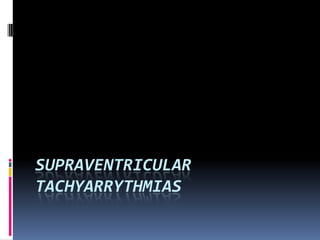
Supraventricular tachyarrythmias
- 2. Supraventricular tachycardia (SVT) is any tachycardic rhythm originating above the ventricular tissue. Paroxysmal supraventricular tachycardia (PSVT) is a rapid rhythm of the heart which involves an accessory pathway.
- 3. Symptoms Pounding chest Shortness of breath Chest pain Rapid breathing Dizziness Loss of consciousness (in serious cases) Numbness of various body parts.
- 4. Types SVTs from a sinoatrial source: Inappropriate sinus tachycardia Sinoatrial node reentrant tachycardia (SANRT)
- 5. SVTs from an atrial source: Ectopic (unifocal) atrial tachycardia (EAT) Multifocal atrial tachycardia (MAT) Atrial fibrillation with a rapid ventricular response Atrial flutter with a rapid ventricular response
- 6. SVTs from an atrioventricular source (junctional tachycardia): AV nodal reenterant tachycardia (AVNRT) or junctional reciprocating tachycardia (JRT) AV reentrant tachycardia (AVRT) - visible or concealed (including Wolff-Parkinson-White syndrome) Junctional ectopic tachycardia.
- 7. Sinus tachycardia Physiological or "appropriate" when a reasonable stimulus, such as the catecholamine surge associated with fright, stress, or physical activity, provokes the tachycardia. It is distinguished by a presentation identical to a normal sinus rhythm except for its fast rate (>100 beats per minute in adults).
- 8. Sinoatrial node reentrant tachycardia (SANRT) Caused by a reentry circuit localised to the SA node, resulting in a normal morphology Pwave that falls before a regular, narrow QRS complex. It is therefore impossible to distinguish on the ECG from physiological sinus tachycardia unless the sudden onset is observed (or recorded on Holter monitor. It may sometimes be distinguished by its prompt response to vagal manoeuvres.
- 9. Ectopic (unifocal) atrial tachycardia Resultant from one ectopic focus within the atria, distinguished by a consistent P-wave of abnormal morphology that falls before a narrow, regular QRS complex.
- 10. Multifocal atrial tachycardia (MAT) Resultant from at least three ectopic foci within the atria, distinguished by P-waves of at least three different morphologies that all fall before irregular, narrow QRS complexes.
- 11. Atrial fibrillation not, in itself, a tachycardia, but when it is associated with a rapid ventricular response greater than 100 beats per minute, it becomes a tachycardia. A-fib is characteristically an "irregularly irregular rhythm" both in its atrial and ventricular depolarizations. It is distinguished by fibrillatory P-waves that, at some point in their chaos, stimulate a response from the ventricles in the form of irregular, narrow QRS complexes.
- 12. Atrial flutter Caused by a re-entry rhythm in the atria, with a regular rate of about 300 beats per minute. On the ECG, this appears as a line of "sawtooth" Pwaves. The AV node will not usually conduct such a fast rate, and so the P:QRS usually involves a 2:1 or 4:1 block pattern. Because the ratio of P to QRS is usually consistent, A-flutter is often regular in comparison to its irregular counterpart, A-fib. Atrial Flutter is also not necessarily a tachycardia unless the AV node permits a ventricular response greater than 100 beats per minute
- 13. AV nodal reentrant tachycardia (AVNRT) Junctional reciprocating tachycardia (JRT), since the atrioventricular junction (AV junction) includes the AV node. It involves a reentry circuit forming just next to or within the AV node itself. The circuit most often involves two tiny pathways one faster than the other, within the AV node. Because the AV node is immediately between the atria and the ventricle, the re-entry circuit often stimulates both, meaning that a retrogradely conducted P-wave is buried within or occurs just after the regular, narrow QRS complexes.
- 14. Atrioventricular reentrant tachycardia (AVRT) Circus movement tachycardia (CMT), also results from a reentry circuit, although one physically much larger than AVNRT. One portion of the circuit is usually the AV node, and the other, an abnormal accessory pathway from the atria to the ventricle. Wolff-Parkinson-White syndrome is a relatively common abnormality with an accessory pathway, the Bundle of Kent crossing the AV valvular ring.
- 15. In orthodromic AVRT, atrial impulses are conducted down through the AV node and retrogradely re-enter the atrium via the accessory pathway. A distinguishing characteristic of orthodromic AVRT can therefore be a P-wave that follows each of its regular, narrow QRS complexes, due to retrograde conduction.
- 16. In antidromic AVRT, atrial impulses are conducted down through the accessory pathway and re-enter the atrium retrogradely via the AV node. Because the accessory pathway initiates conduction in the ventricles outside of the bundle of His,the QRS complex in antidromic AVRT is often wider than usual, with a delta wave.
- 17. Junctional ectopic tachycardia (JET) A rare tachycardia caused by increased automaticity of the AV node itself initiating frequent heart beats. On the ECG, junctional tachycardia often presents with abnormal morphology P-waves that may fall anywhere in relation to a regular, narrow QRS complex. It is often due to drug toxicity.
